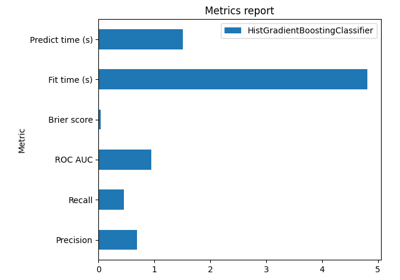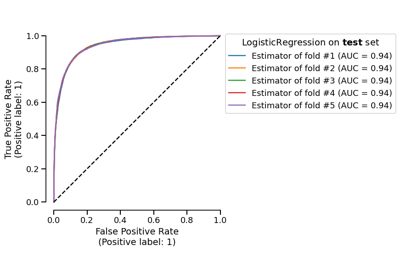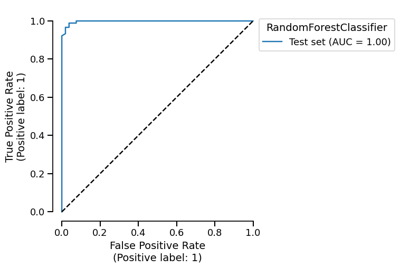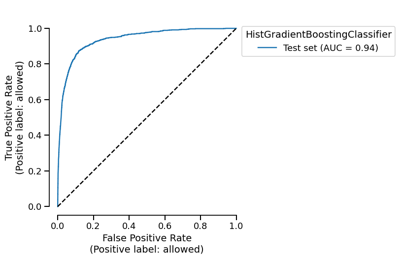RocCurveDisplay#
- class skore.RocCurveDisplay(*, fpr, tpr, roc_auc, estimator_names, pos_label, data_source, ml_task, report_type)[source]#
ROC Curve visualization.
An instance of this class is should created by
EstimatorReport.metrics.roc(). You should not create an instance of this class directly.- Parameters:
- fprdict of list of ndarray
False positive rate. The structure is:
- for binary classification:
the key is the positive label.
the value is a list of
ndarray, eachndarraybeing the false positive rate.
- for multiclass classification:
the key is the class of interest in an OvR fashion.
the value is a list of
ndarray, eachndarraybeing the false positive rate.
- tprdict of list of ndarray
True positive rate. The structure is:
- for binary classification:
the key is the positive label
the value is a list of
ndarray, eachndarraybeing the true positive rate.
- for multiclass classification:
the key is the class of interest in an OvR fashion.
the value is a list of
ndarray, eachndarraybeing the true positive rate.
- roc_aucdict of list of float
Area under the ROC curve. The structure is:
- for binary classification:
the key is the positive label
the value is a list of
float, eachfloatbeing the area under the ROC curve.
- for multiclass classification:
the key is the class of interest in an OvR fashion.
the value is a list of
float, eachfloatbeing the area under the ROC curve.
- estimator_nameslist of str
Name of the estimators.
- pos_labelint, float, bool, str or None
The class considered as positive. Only meaningful for binary classification.
- data_source{“train”, “test”, “X_y”}
The data source used to compute the ROC curve.
- ml_task{“binary-classification”, “multiclass-classification”}
The machine learning task.
- report_type{“comparison-estimator”, “cross-validation”, “estimator”}
The type of report.
- Attributes:
- ax_matplotlib axes
The axes on which the ROC curve is plotted.
- figure_matplotlib figure
The figure on which the ROC curve is plotted.
- lines_list of matplotlib lines
The lines of the ROC curve.
- chance_level_matplotlib line
The chance level line.
Examples
>>> from sklearn.datasets import load_breast_cancer >>> from sklearn.linear_model import LogisticRegression >>> from sklearn.model_selection import train_test_split >>> from skore import EstimatorReport >>> X_train, X_test, y_train, y_test = train_test_split( ... *load_breast_cancer(return_X_y=True), random_state=0 ... ) >>> classifier = LogisticRegression(max_iter=10_000) >>> report = EstimatorReport( ... classifier, ... X_train=X_train, ... y_train=y_train, ... X_test=X_test, ... y_test=y_test, ... ) >>> display = report.metrics.roc() >>> display.plot(roc_curve_kwargs={"color": "tab:red"})
- plot(ax=None, *, estimator_name=None, roc_curve_kwargs=None, plot_chance_level=True, chance_level_kwargs=None, despine=True)[source]#
Plot visualization.
Extra keyword arguments will be passed to matplotlib’s
plot.- Parameters:
- axmatplotlib axes, default=None
Axes object to plot on. If
None, a new figure and axes is created.- estimator_namestr, default=None
Name of the estimator used to plot the ROC curve. If
None, we use the inferred name from the estimator.- roc_curve_kwargsdict or list of dict, default=None
Keyword arguments to be passed to matplotlib’s
plotfor rendering the ROC curve(s).- plot_chance_levelbool, default=True
Whether to plot the chance level.
- chance_level_kwargsdict, default=None
Keyword arguments to be passed to matplotlib’s
plotfor rendering the chance level line.- despinebool, default=True
Whether to remove the top and right spines from the plot.
Examples
>>> from sklearn.datasets import load_breast_cancer >>> from sklearn.linear_model import LogisticRegression >>> from sklearn.model_selection import train_test_split >>> from skore import EstimatorReport >>> X_train, X_test, y_train, y_test = train_test_split( ... *load_breast_cancer(return_X_y=True), random_state=0 ... ) >>> classifier = LogisticRegression(max_iter=10_000) >>> report = EstimatorReport( ... classifier, ... X_train=X_train, ... y_train=y_train, ... X_test=X_test, ... y_test=y_test, ... ) >>> display = report.metrics.roc() >>> display.plot(roc_curve_kwargs={"color": "tab:red"})
- set_style(**kwargs)[source]#
Set the style parameters for the display.
- Parameters:
- **kwargsdict
Style parameters to set. Each parameter name should correspond to a a style attribute passed to the plot method of the display.
- Returns:
- selfobject
Returns the instance itself.
- Raises:
- ValueError
If a style parameter is unknown.
Gallery examples#

EstimatorReport: Get insights from any scikit-learn estimator


